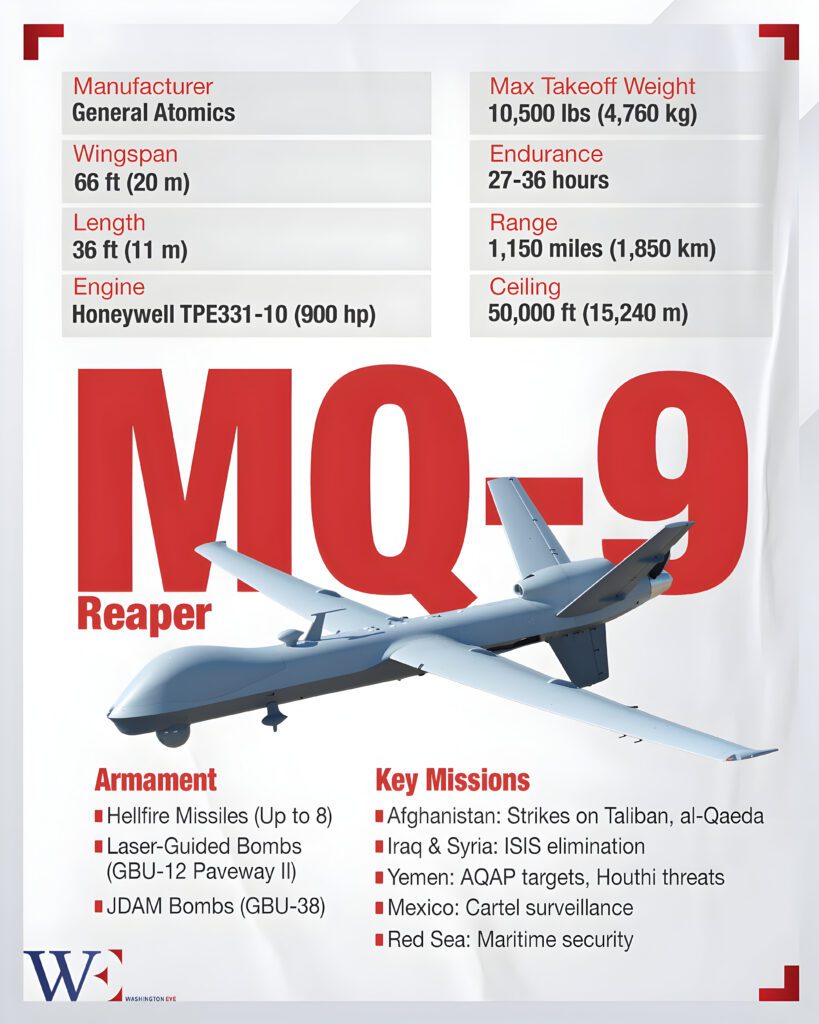The faint hum of a drone was barely perceptible against the backdrop of the desert night. Thousands of miles away, inside a heavily secured U.S. military command center, intelligence officers sat hunched over their monitors, eyes locked on the grainy footage being relayed in real-time from an MQ-9 Reaper drone hovering over northern Yemen. Their target—a high-ranking terrorist operative—had just stepped out of a black SUV, flanked by two bodyguards. Inside the compound ahead of him, more armed men waited. The compound had been under surveillance for weeks, each movement tracked and analyzed, every vehicle entering and leaving logged.
A hushed conversation filled the room as the team received final confirmation: no civilians were visible within the blast radius. The officer in charge gave the order. Thousands of feet above the target, the drone’s payload doors opened, releasing a Hellfire missile that sliced through the air at blistering speed. The compound erupted in a fireball, sending a thick column of smoke into the night sky. Moments later, as the dust settled, heat-sensing cameras captured scattered figures scrambling—some wounded, some lifeless. The mission was deemed a success. A threat had been neutralized, but the broader questions remained: Was this strike truly necessary? Were any unintended casualties involved? And with the evolving rules of engagement, how would future operations unfold?
For decades, the United States has relied on military airstrikes and special operations raids as key instruments in its counterterrorism and foreign policy strategy. However, the rules governing these operations have evolved significantly, reflecting broader shifts in military doctrine, ethical considerations, and international relations. The recent policy change under President Donald Trump marks another significant shift, granting military commanders more autonomy in launching operations while rolling back restrictions imposed by the Biden administration.
This shift represents a stark departure from the previous approach, which sought to centralize decision-making and minimize civilian casualties. While proponents argue that the change enhances operational efficiency and responsiveness, critics warn of the potential for unintended consequences, including increased civilian harm and diplomatic tensions.
A Historical Overview of U.S. Military Airstrikes and Raids
Airstrikes have long been a critical component of U.S. military strategy, evolving from large-scale bombing campaigns in conventional wars to precision strikes in counterterrorism missions.
During World War II, air power played a decisive role in shaping battle outcomes. The 1942 Doolittle Raid demonstrated the U.S. military’s ability to strike deep into enemy territory, while the atomic bombings of Hiroshima and Nagasaki underscored the devastating potential of aerial warfare. In the Vietnam War, Operation Rolling Thunder (1965–1968) sought to weaken North Vietnam’s war-making capacity, though it faced criticism for high civilian casualties and limited strategic effectiveness.
In the aftermath of the 9/11 attacks, the United States expanded its reliance on precision airstrikes, particularly through drone warfare. Targeted strikes became a hallmark of U.S. counterterrorism efforts, aimed at eliminating high-value targets in Afghanistan, Pakistan, Yemen, and Somalia. While these operations successfully disrupted terrorist networks, they also ignited debates over sovereignty, legality, and the impact on civilian populations.
The Rationale Behind Airstrikes and Raids
The motivations for conducting airstrikes and special operations raids are deeply rooted in national security objectives.
First and foremost, such operations are designed to neutralize high-value targets, including terrorist leaders and key operatives, thereby disrupting their organizational structures and operational capabilities. Additionally, intelligence-driven strikes aim to preempt planned attacks against U.S. and allied interests, reinforcing America’s counterterrorism posture.
Beyond targeting individuals, airstrikes serve broader strategic purposes. They are employed to disrupt enemy supply chains, command centers, and training facilities, undermining an adversary’s ability to sustain operations. Moreover, the use of airstrikes is often a demonstration of military power, deterring adversaries and reassuring allies of U.S. capabilities.
The Shift in Policy: Then vs. Now
Under President Joe Biden, the U.S. military operated under stricter guidelines governing airstrikes and special operations raids. The administration sought to minimize civilian casualties and ensure strict oversight by requiring high-level approval for military actions, particularly in regions outside active war zones. These policies reflected a broader shift toward prioritizing diplomacy and de-escalation over unilateral military action.
The Biden administration’s policies aimed to reintroduce greater accountability into military operations. Any planned strike required a comprehensive assessment of potential collateral damage, with intelligence teams verifying that each target posed an imminent and continuous threat. This approach significantly slowed the approval process but was designed to reduce the risk of civilian casualties and to align military actions with diplomatic goals.
However, under President Donald Trump, these rules have been significantly altered. The new policy removes many of the bureaucratic hurdles that slowed decision-making under Biden, allowing military commanders in the field to authorize strikes without requiring approval from Washington. This shift is intended to provide commanders with the autonomy to act quickly and decisively in response to intelligence threats.
Key changes under Trump’s policy include:
- Expanded Targeting Authority: Military officials now have broader discretion to identify and engage enemy combatants, with less stringent vetting of targets.
- Reduced Oversight: The requirement for White House or high-level Pentagon approval before launching an attack has been lifted for most cases.
- Faster Response Times: Commanders on the ground can make real-time decisions without waiting for bureaucratic clearance.
- Increased Operational Secrecy: Some aspects of drone strike and airstrike programs may no longer require extensive reporting, making it harder for the public and international organizations to track operations.
- Greater Use of Drone Warfare: With fewer restrictions, drone strikes can now be used more aggressively in regions where terrorist threats are identified.
While supporters argue that this approach restores the military’s ability to swiftly eliminate threats, critics warn that it removes essential safeguards designed to prevent unnecessary loss of life. Without the stringent oversight imposed by previous administrations, civilian casualties may increase, leading to diplomatic fallout and potential violations of international law.
The Implications of the Policy Shift
The transition from a centralized approval system to a more autonomous operational framework carries both advantages and risks.
On one hand, supporters argue that this change enhances the effectiveness of counterterrorism operations. Commanders can act swiftly on intelligence, reducing bureaucratic delays that might allow adversaries to evade capture or elimination. Increased autonomy also enables a more aggressive stance against terrorist groups, potentially deterring future threats.
However, the policy shift raises concerns regarding accountability and civilian safety. With fewer checks and balances, the risk of unintended casualties increases, which could fuel anti-American sentiment and serve as a recruitment tool for terrorist organizations. Legal and ethical questions also emerge, as the looser targeting rules may lead to violations of international law and human rights norms. Additionally, unilateral military actions, particularly in volatile regions, could strain diplomatic relationships and provoke backlash from allies and affected nations.
The evolution of U.S. airstrike policy highlights the complex interplay between military strategy, ethics, and international diplomacy. While the Trump administration’s changes aim to bolster operational efficiency, they also underscore the delicate balance between military necessity and responsible warfare.
As history has demonstrated, airstrikes are powerful tools with far-reaching consequences, and their use demands careful consideration of both immediate objectives and long-term implications.













